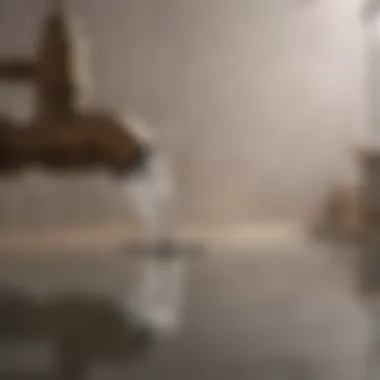Natural Solutions to Clear Clogged Drains Effectively


Intro
Clogged drains present a common yet vexing issue in homes. Many homeowners turn to chemical solutions to unclog their pipes. However, these can often lead to more damage in the long run. This article explores the concept of using natural methods to clear clogged drains. Not only do natural solutions dissolve blockages effectively, they are also safer for your plumbing systems and the environment.
Using household items, such as vinegar, baking soda, and salt, is both economical and simple. By understanding the science behind these materials, you can apply them successfully in your home. This guide is specifically beneficial for homeowners who prefer sustainable solutions without resorting to harmful chemicals.
Key Points to be Discussed
- Popular natural ingredients and their effectiveness
- Step-by-step procedures for unclogging drains
- Preventative maintenance tips to keep drains clear
By the end of this article, you will have a comprehensive understanding of how to tackle clogged drains naturally. This knowledge will empower you to maintain a healthy plumbing system while being considerate of the environment.
Understanding Drain Clogs
Clogged drains can cause various problems in households, from minor inconveniences to significant plumbing issues. Understanding drain clogs is vital to effectively address and prevent them. In this section, we explore the fundamental aspects of clogs, including their causes and the signs that indicate a clog is present. A deeper understanding of this subject equips homeowners with the knowledge necessary to maintain their plumbing systems efficiently.
Causes of Clogged Drains
Hair Buildup
Hair buildup is a common cause of clogged drains, particularly in bathrooms. Human and pet hair can accumulate over time, creating a dense mass that obstructs water flow. This is especially relevant in shower drains and sinks. Addressing hair buildup is beneficial because it is often manageable with simple preventative measures. The unique feature of hair is that it clings to other debris, making clogs worse. Regular hair removal from drain covers can prevent significant issues.
Food Particles
Food particles often lead to drain clogs in kitchens. Leftover food, grease, and oil can accumulate, solidifying and forming a blockage. This is critical to note for those who frequently dispose of food waste down the sink. The key characteristic of food particles is their organic nature, making them prone to decomposition, which can cause unpleasant odors. Proper disposal practices, such as using a garbage disposal unit or composting, can mitigate this issue. However, small particles can still find their way into pipes, so occasional cleaning is important.
Soap Scum
Soap scum is a residue resulting from the reaction between soap and hard water minerals. This sticky substance often forms in bathtubs and sinks, leading to gradual buildup that can impede water flow. Soap scum is a critical contributor to clogs due to its ability to trap other debris. While it may not be as prominent as other causes, its persistence means that regular cleaning is essential. The unique feature of soap scum is that it can be softened and removed through natural cleaning agents, making it an easier target for preventative measures.
Mineral Deposits
Mineral deposits affect drains, particularly in areas with hard water. Over time, minerals such as calcium and magnesium can accumulate, narrowing the pipes and causing blockages. This aspect is significant in plumbing systems where minerals precipitate from water, forming layers that build up over time. The key characteristic of mineral deposits is their slow accumulation, often going unnoticed until a significant clog occurs. Regular maintenance, such as flushing the system with vinegar or using a water softener, can alleviate this problem.
Signs You Have a Clogged Drain
Slow Draining Water
One of the first signs of a clogged drain is slow draining water. If water stands in sinks or bathtubs for an extended period, it indicates that something is obstructing the flow. Slow draining water can significantly impact daily activities, making it a critical sign to address. Observing these symptoms helps homeowners act before the situation worsens. The unique feature of this sign is its increase over time, often giving a chance for early intervention.
Unpleasant Odors
Unpleasant odors emanating from drains often signal a blockage. When waste materials become trapped, they decompose, releasing foul smells. This is particularly relevant in kitchen and bathroom sinks. Not only are these odors unpleasant, but they can also indicate larger issues in the plumbing system. The distinct characteristic of unpleasant odors is how they impact indoor air quality, signifying a need for immediate attention to prevent escalation.
Gurgling Sounds
Gurgling sounds from the drain are another indicator of a clog. This noise suggests that air is trying to escape through a blockage. While it may seem minor, gurgling can signal that water is unable to flow freely. Recognizing this sound early can lead to timely preventative actions. The unique feature of gurgling sounds is that they can vary depending on the severity of the clog, which can guide the homeowner on how urgent the situation is.
Natural Methods for Clearing Drains
The exploration of natural methods for clearing drains is vital, especially in a world increasingly conscious of environmental impacts. Many homeowners seek alternatives to chemical cleaners, which can be harsh on both plumbing systems and the surrounding ecosystem. Natural methods offer effective solutions while reducing chemical exposure. Choosing these options leads to safer household environments and often lower costs.
Natural methods capitalize on common household ingredients, which are not only accessible but also inexpensive. The use of these techniques encourages a sustainable mindset, promoting routines that prevent clogs before they occur. Each method has unique benefits, and understanding these can provide clarity on how to maintain plumbing health effectively.
Baking Soda and Vinegar
Chemical Reaction


Baking soda and vinegar create a notable chemical reaction when combined. When baking soda, a base, meets vinegar, an acid, they produce carbon dioxide gas and various other compounds. This reaction is beneficial because it helps to dislodge buildup in pipes. The fizzing motion can loosen particulate matter, making the drain less likely to become clogged.
This method stands out due to its straightforward nature and availability in most households. The reaction can produce effective cleaning effects without risking harm to the plumbing. However, while the reaction is safe and generally effective, it may not reach deeper blockages if they are particularly stubborn.
Application Method
To use this method effectively, one should first pour a half cup of baking soda down the drain, followed by an equal amount of vinegar. After letting the mixture sit for at least 30 minutes, flushing the drain with hot water is essential. This routine allows the reaction to work while providing a thorough cleanse to the pipes.
Using this technique has the advantage of simplicity; it does not require specialized tools or skills. Nevertheless, overuse can lead to residue buildup, so moderation is key in employing this method routinely.
Effectiveness
The effectiveness of the baking soda and vinegar method varies depending on the nature and severity of the clog. It is particularly good for organic blockages such as hair and soap scum. For routine maintenance, this natural solution can keep drains clear and functioning efficiently.
However, deep-rooted clogs or those caused by solid debris may require more intensive measures. Thus, while effective for minor troubles, it should not be solely relied upon for severe blockages.
Salt and Hot Water
How It Works
When salt is poured down a drain, it interacts with any clog-producing materials. The salt's abrasive quality helps dislodge buildup, while hot water works to dissolve things like grease and food particles. This combination of salt and heat effectively reduces blockages.
This method's primary advantage is its ease of use. The two ingredients are common household items, making this method accessible to nearly everyone. However, it is less effective on stubborn clogs that might require more intensive remedies.
Best Application Practices
To apply this method, it is suggested to use a half cup of salt and follow it with about two liters of hot water. This should be done in the evening and left overnight for optimal effect, allowing time for the salt to work on any clogs while the water helps break them down.
The simplicity of this practice offers non-invasive drain clearing techniques. On the downside, this technique may not work with all types of clogs, particularly those caused by solid objects.
Limitations
While salt and hot water can provide relief from mild clogs, it has limitations, especially with more severe blockages. Heavy grease buildups or mixed materials may call for more robust solutions. Furthermore, routine reliance on this method may lead to mineral deposits that could clog up pipes over time.
Enzymatic Cleaners
Definition and Function
Enzymatic cleaners rely on enzymes that break down organic material within clogs. These solutions work by digesting substances like grease and food particles, turning them into harmless waste. This process supports a healthy plumbing ecosystem while minimizing the potential for damage.
Enzymatic cleaners are becoming popular due to their eco-friendliness. They are notably less harmful to the environment than harsh chemical alternatives. However, while they are effective with minor clogs, their usability time can be longer than immediate chemical agents, making them less suitable for urgent situations.
DIY Enzymatic Solutions
Creating your own enzymatic cleaners is an option many have found effective. A common recipe involves using a mixture of baking soda, vinegar, and water, allowing natural enzymes to break down buildup gradually. This DIY approach promotes utilization of ingredients at hand and fosters a sustainable method of cleaning.
However, the drawback to DIY solutions can be variability in results. Homemade solutions might not be as potent as store-bought options designed for specific functions, especially with tougher clogs.
Commercial Options
Those looking for a straight-forward approach might choose commercial enzymatic cleaners. Products like Bio-Clean or Zep can quickly break down organic material effectively. They typically offer immediate results and ease of use. A strong point of commercial solutions is that they are often tested and proven to handle various blockages.
However, cost can be a factor, and as with all solutions, one must carefully read labels to ensure safety and effectiveness. Relying solely on these products without considering broader preventative measures may lead to repeated drain issues.
Essential Oils
Recommended Oils


Certain essential oils like tea tree oil or lavender oil can offer a fresh scent while supporting drain health. These oils possess antibacterial properties, aiding in the breakdown of organic matter. Their pleasant aroma adds an aesthetic benefit in addition to their cleaning capabilities.
Though aromatic, the use of essential oils offers limited direct benefit for physical clogs. They are best used as a supplementary cleaning method rather than a primary solution.
Dilution and Usage
It is vital to dilute essential oils before using them down drains. A few drops mixed with a half cup of carrier oil or alcohol ensures safe application. Pouring the diluted solution may help deodorize pipes while offering some maintenance support.
However, trusting solely on essential oils in place of stronger remedies might lead to ineffectiveness in tackling genuine clogs, signifying the need for blended approaches to upkeep.
Additional Benefits
Introducing essential oils into routine maintenance can have various benefits, including reduced buildup of bacteria and an aromatic environment. Using oils like eucalyptus or mint can also enhance overall home ambiance.
Nonetheless, while they offer additional perks, they should not be the sole dependents for drain maintenance but rather an accompaniment to more substantial practices.
Preventative Measures for Drain Maintenance
Maintaining clear drains is a critical aspect of avoiding costly plumbing repairs and inconveniences. Preventative measures serve as the first line of defense against drain clogs. These strategies not only extend the life of your plumbing system but also improve the overall efficiency of your home’s water flow. Implementing simple maintenance routines can save time and money in the long run. Moreover, these methods are environmentally friendly, making them a suitable choice for conscientious homeowners.
Regular Cleaning Routines
Monthly Maintenance
Monthly maintenance involves proactively cleaning your drains to prevent buildup. This might include using natural solutions such as baking soda or vinegar. The key characteristic of monthly maintenance is its frequency and consistency. Regular cleaning helps to prevent blockages from developing into severe issues. This method is beneficial since it can be done quickly and requires minimal resources.
The unique feature of monthly maintenance is its simplicity; it can be seamlessly integrated into your routine. Advantages include ensuring that minor issues do not escalate, while disadvantages might be the additional effort required to maintain this schedule. All in all, monthly maintenance represents an effective and practical approach to drain management.
Seasonal Checks
Seasonal checks are another important aspect of drain maintenance. This involves more thorough inspections to assess the condition of your plumbing and clear any potential obstacles. The main characteristic of seasonal checks lies in their comprehensiveness. This is a beneficial practice as it allows homeowners to catch problems before they become significant, especially during times of heavy use like holidays.
A unique feature of seasonal checks is their adaptability; they can be timed with seasonal chores, making them easier to remember. Advantages include the ability to perform a proactive maintenance strategy while disadvantages may include the need for a slightly longer time commitment. Seasonal checks contribute significantly to ensuring the reliability of your drainage system.
Proper Disposal Practices
Food Waste Management
Food waste management focuses on how homeowners dispose of food scraps. This practice reduces the likelihood of clogs due to organic materials breaking down in the drains. Its key characteristic is its proactive nature. Implementing proper disposal methods, like composting or using garbage disposals efficiently, is a beneficial solution to maintaining clear drains.
The unique feature of food waste management lies in the choice of disposal methods. Properly managed waste streamlines the breakdown process and reduces odors in plumbing systems. Advantages of this practice include enhanced hygiene and reduced clogging; however, if not done correctly, there can still be issues with disposal obstructions.
Avoiding Harsh Chemicals
Avoiding harsh chemicals is essential when maintaining drain health. Many chemical cleaners can wear down pipes over time, ultimately leading to costly problems. A key characteristic of this approach is its focus on using natural solutions instead. This practice is beneficial because it promotes a healthier plumbing environment while being safer for users and the ecosystem.
The unique aspect of this recommendation is its emphasis on natural alternatives like vinegar, baking soda, and enzymatic cleaners. The advantages include improved longevity of plumbing systems and reduced environmental impact. On the downside, natural solutions may not always be as fast-acting as chemical options. It is still important to adopt this method for the well-being of your plumbing system.
Use of Drain Screens
Types of Screens
Drain screens provide a physical barrier to prevent debris from entering the plumbing system. Various types of screens exist, and their effectiveness in keeping drains clear is notable. The key characteristic of drain screens is their straightforward utility. These tools are beneficial as they easily fit over drains, capturing hair and larger particles preventing blockages.
Different materials, such as stainless steel or plastic, offer unique features. Stainless steel is more durable, while plastic may be less expensive. Advantages include minimal maintenance and ease of installation; however, if not cleaned regularly, they may lose effectiveness due to accumulated debris.
Installation Tips


Proper installation of drain screens is crucial for maximal effectiveness. The main characteristic of this practice is ensuring a snug fit over the drain. A beneficial choice for this article, proper installation prevents the entry of unwanted materials that can cause clogs.
A unique feature of installation tips is following specific manufacturer guidelines or general best practices. This may involve cleaning the area before placement and ensuring the screen fits correctly. The advantages of correct installation include enhanced drain protection; however, disadvantages may arise if homeowners choose incorrect sizes or materials.
When to Seek Professional Help
Understanding when to engage professional help for clogged drains is crucial for maintaining your plumbing system's integrity. While many natural solutions can alleviate minor issues, some situations require a trained expert. Not addressing serious plumbing problems in a timely manner can result in larger, more costly repairs.
Identifying Severe Clogs
Recurring Blockages
Recurring blockages in your drains indicate an underlying issue that likely can't be resolved with simple methods. These clogs are a significant sign that professional assessment is necessary. One key characteristic of these blockages is frequency; if you find yourself repeatedly unclogging the same drain, it's an indication of a deeper problem.
This persistent issue can stem from various sources, such as damaged pipes or excess buildup in your plumbing system. Notably, relying on DIY solutions may only be a temporary fix. A professional can analyze the situation thoroughly and provide effective solutions tailored to the specific cause of these recurring issues.
Advantages of addressing recurring blockages promptly include preventing further damage and maintaining the efficiency of your plumbing system. However, the disadvantage lies in the potential expense of ongoing DIY attempts failing to provide a long-term solution, leading to the inevitable need for professional intervention later on.
Multiple Drains Affected
When multiple drains exhibit signs of clogging, it calls for immediate attention. This condition suggests a blockage in the main sewer line. The key characteristic of multiple drains affected is their interconnected nature; if several are slower than usual or backing up, it may indicate a larger problem that your standard solutions cannot handle.
This scenario is particularly beneficial to mention in our guide, as it highlights the need to differentiate between benign clogs and more serious sewer line issues. Homeowners may underestimate the significance of such widespread symptoms, thinking they can manage it themselves.
Notably, the unique feature of having multiple drains affected is that failure to address this promptly can result in significant water damage within your home. Thus, while DIY methods may seem feasible, the disadvantages of ignoring this issue are considerable. Engaging a professional ensures that the plumbing system receives the necessary care to prevent extensive damage.
Understanding Plumbing Systems
Complexity of Your System
Plumbing systems vary significantly from one household to another, depending on age, layout, and overall design. The complexity of your system plays a crucial role in determining the best course of action. A key feature of complex systems is the intricate network of pipes that may have several twists and turns.
This complexity makes it difficult for homeowners to diagnose issues accurately without the right tools and expertise. In this context, professionals bring valuable insights, ensuring accurate identification and repair of problems. Moreover, the proper understanding of your plumbing system can prevent missteps that could worsen the situation.
The advantage of recognizing complexity is the awareness it brings to the situation. Understanding that plumbing can be intricate should prompt homeowners to value professional assessments. Conversely, attempting to navigate this complexity without experience can lead to costly mistakes.
Risks of DIY Solutions
While many homeowners prefer DIY solutions for clogged drains, it's essential to acknowledge the risks involved. DIY methods, while cost-effective and straightforward, can often overlook underlying issues or result in further complications. The key characteristic of these risks is that they can compound existing issues, leading to more significant problems over time.
One notable aspect is the possibility of causing damage to plumbing fixtures through improper techniques or using inappropriate tools. For example, aggressive snaking or the wrong chemicals can inflict harm rather than help. Thus, the unique feature of these risks is their potential to escalate the situation rather than provide effective resolution.
The advantages of recognizing these risks include the ability to make informed decisions. Homeowners can ask themselves if tackling a clog is worth the potential hazards involved. Understanding these risks underscores the argument for seeking professional assistance when warranted. Instead of a quick fix, a professional offers a comprehensive solution that safeguards your plumbing system.
Seeking the help of professionals when dealing with serious plumbing issues is an investment in the longevity of your home's plumbing system.
Finale
In this article, we explored various natural methods to address clogged drains. Understanding the importance of these methods is critical for homeowners, especially those keen on sustainability. Natural solutions offer a way to clear blockages without resorting to harsh chemicals that may harm the environment or damage plumbing.
Recap of Natural Methods
The natural methods discussed include:
- Baking Soda and Vinegar: This combination creates a chemical reaction that can help dissolve tough clogs. It is effective and simple, requiring just two common household items.
- Salt and Hot Water: Using salt with hot water can neutralize blockages. It is a practical solution that helps maintain clean pipes without much effort.
- Enzymatic Cleaners: These solutions break down organic materials in drains. DIY options can be prepared with common ingredients. There are also commercial enzymatic cleaners available.
- Essential Oils: Certain oils not only help in maintaining clarity in drains but can also add pleasant scents. Different oils can offer varying benefits.
Long-term Benefits of Natural Solutions
Implementing natural solutions offers several long-term benefits:
- Eco-Friendly: By avoiding harsh chemicals, homeowners contribute to environmental preservation.
- Cost-Effective: Using common household items for drain maintenance reduces the need for specialized products and can save money.
- Healthier Homes: Natural methods minimize the risk of harmful fumes and substances entering the home.
- Plumbing Longevity: Consistently using gentle solutions can prolong the life of plumbing systems.
"Cleaning drains naturally is beneficial for both the home and the planet."
By integrating these methods into routine maintenance, individuals can enjoy free-flowing drains and a healthier living environment.















